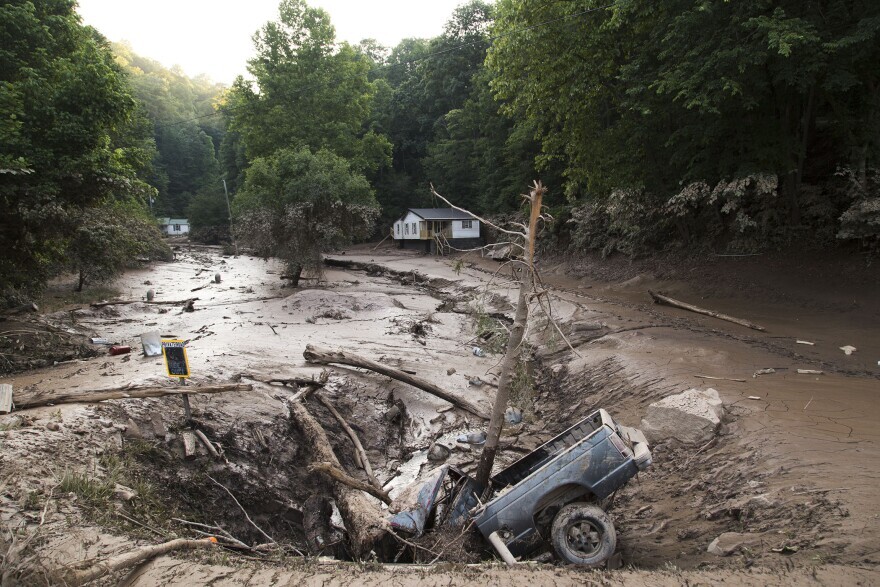Financial funding matters around West Virginia Volunteer Organizations Active in Disaster (VOAD) have been referred to the Committee on Special Investigations, the state Auditor and the legislative auditor.
Financial funding matters around West Virginia Volunteer Organizations Active in Disaster (VOAD) have been referred to the Committee on Special Investigations, the state Auditor and the legislative auditor.
This came after a back-and-forth discussion between Senate Finance Chair Sen. Eric Tarr, R-Putnam, and Jenny Gannaway, the executive director of the organization during the Joint Legislative Committee on Flooding meeting Sunday.
A video recently surfaced on the Facebook page ScoopSquad that appeared to show Gannaway directing employees to sell donated items for a tenth of their value to employees. Tarr also raised a number of concerns about employees taking donated items like patio furniture and fire pits home after making a donation to the organization. Tarr asked Gannaway if she had personally taken items to her home in Matewan, but she replied that they had gone to her home in Roanoke.
VOAD has been working in the state since 2016 doing flood relief projects like rebuilding bridges torn out by high water and raising and rebuilding homes. The organization gets its money through state and federal grant funding as well as corporate donations and grants.
Gannaway began the presentation to the committee detailing some of the organization’s recent work.
“Our goal after that was to build our capacity here in this state… we now have a shower unit that can be deployed within hours and six washers and six dryers,” she said. “We have currently built 169 bridges, 54 of those was used from using CDBG (Community Development Block Grants). And 115 of them was using private donations and donations that had came to West Virginia.”
Once Gannaway’s presentation was completed, however, Tarr began questioning the money that flows through the organization and how it was used.
“I’m sure you’re aware of videos and pictures that have come out that question some of the behaviors that you personally have had,” Tarr said.
Gannaway replied that she was aware of the video but had not personally seen it.
Tarr also asked about the organization’s hiring practices and the hiring of family members including Gannaway’s brother, great niece and great nephew-in-law without board approval.
Gannaway explained the hirings occurred during the COVID-19 pandemic when it was difficult to hire employees. She noted that the organization hired family members from several other employees.
“Looking back on that, that was probably something I would never do again. But at that time when we had to get things done,” she said.
Then Tarr asked questions about specific items that were donated but ended up at Gannaway and other employees’ homes.
“Did you take as your own seven pieces of items donated to VOAD? They were valued at $600 to $2,000, to write them off rather than record them as write offs as a way to not have to have them on the books as they went to your house,” Tarr asked.
“I did not say to write anything off,” Gannaway said. “We had permission to take donations for items that we could not give out to flood survivors. And I gave large donations for anything that I took that I might have given to someone.”
Gannaway also said she has since donated many of those items to other people. Tarr asked if that happened since the information about the items came to light and she said it was before.
Tarr also questioned her use of a VOAD rental truck, paid for using grant money, to transport approximately $4,000 worth of items from VOAD’s warehouse to her home in Roanoke.
“Was he on VOAD’s checkbook?” Tarr asked. “Did he pay for that rental truck with dollars or any dollars VOAD received?”
“The rental truck had been leased by West Virginia VOAD. And we did use that truck but also I did pay him to do what he done out of my own pocket,” she said.
Tarr also questioned giving certain VOAD employees “Hero” bonuses of more than $7,000 each including Gannaway.
“It was told to me from our CFO at that time that he had cleared this with our CPA and our auditor,” Gannaway said. “We had had employees working weekends and things and was not paid for those times.“
Gannaway said she could not recall how much her hero bonus was.
At the end of the meeting, Tarr put forth the motion to have the Committee on Special Investigations, the state Auditor and the legislative auditor review the state funds that have been given to VOAD for flood recovery work.
“In light of the discussion with Miss Galloway, I’m not convinced that the funds that went through VOAD were used appropriately. I’m not sure how much of that would have been state dollars with just even the recent appropriations, let alone what’s happened since 2016,” Tarr said. “Those state dollars that have been involved that were directly related to Miss Gannaway’s supervision, and probably the board as a whole, also should be referred to state Auditor. I’m pretty sure the state Auditor has not had a chance to look at especially these most recent funds.”
